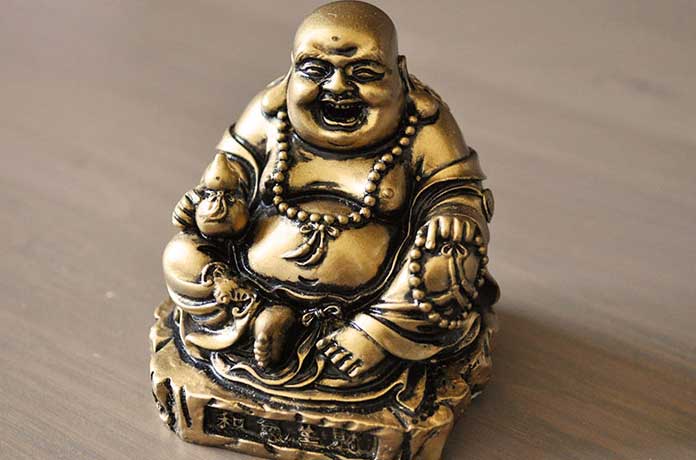1. History of Laughing Buddha
The heavenly Buddha named Hotei or Pu-Tai is best known as the sprightly Laughing Buddha. He depends on an offbeat Chinese Ch’an (Zen) priest who lived more than 1,000 years back and has turned into a critical piece of Buddhist and Shinto culture. In view of this current priest’s altruistic nature, he came to be viewed as a manifestation of the bodhisattva will’s identity Maitreya (the Future Buddha). His huge jutting stomach and sprightly grin have given him the regular assignment “Giggling Buddha.”
2. The legend of Laughing Buddha
I am extremely partial to gathering chuckling Buddhas. They looked extraordinary, spread everywhere on my home, and I firmly trusted that they are overflowing of Good Luck and will before long get me incredible fortunes. More than the destiny they brought (or didn’t), they brighten me up and I adore having them around me, so I figured I would impart to you their genuine noteworthiness. In this way, here’s a down and out of all that you at any point needed to think about these adorable looking holy people…
3. Benefactor of the frail, poor and kids
Snickering Buddha statues portray a strong, grinning or chuckling bare man in robes with a generally uncovered pot tummy stomach, which symbolizes bliss, good fortunes, and wealth. His picture graces numerous sanctuaries, eateries, and ornaments, as he has turned into a god of happiness and plenitude. The picture of Hotei is quite often observed conveying a material or cloth sack which is loaded up with numerous valuable things, including rice plants, treat for youngsters, sustenance, or the burdens of the world.
4. Snickering Buddha With a bowl and a fan
A thing that is generally observed with the Laughing Buddha figure is an asking dish to speak to his Buddhist nature. In a few scenes the Laughing Buddha might be discovered sitting on a truck drawn by young men, or employing a fan called an ‘Oogi’ (a ‘wish giving’ fan, this sort of fan was utilized by the nobility to demonstrate to vassals that their solicitations would be conceded). These pictures show Hotei as a meandering priest who goes around and takes the trouble from individuals of this world.
5. Rubbing Laughing Buddha gut
As indicated by legend, on the off chance that you rub the Laughing Buddha’s awesome midsection, it delivers riches, good fortunes, and thriving. Hotei is additionally alluded to as the supporter holy person of restaurateurs, psychics and barkeeps. When one gorges or over beverages, companions tongue in cheek credit it to the Laughing Buddha’s impact. Throughout the years, he has come to speak to a few useful qualities, for example, bliss, thriving, contentme
6. Giggling Buddha is an image of satisfaction and riches
Place a Buddha in your home to include an air of satisfaction and quietness. He is there to remind us not to work too hard or end up insatiable. It is exceptionally favorable to light a flame on his birthday (eighth May) and you can request that he allow any uncommon solicitations that you may have.
7. Snickering Buddha in Feng Shui
Feng Shui centers around the genuine position of the situation and heading the Fat Buddha statue is confronting. In Feng Shui, the explanation behind purchasing and putting dolls or statues in the house is to rectify a specific irregularity in your life. The position of specific dolls in a specific part or course of the house is intended to bring concordance and request into your life, giving you a chance to encounter a more tranquil and prosperous life. Investigate the headings prescribed to determine different issues…
8. Heading to determine family strains
On the off chance that your family experiences contentions and strains, at that point a picture or puppet of the Laughing Buddha will tackle these issues. Essentially put him in the East Sector (Family Luck) (Feng Shui Bagua Formula) or an area where he can be seen when everybody is lounging around in your front room or fundamental lobby.
9. Bearing to pull in or riches
For the individuals who wish to improve their fortunes in the parts of riches, self-advancement, prosperity and triumph, showing the Laughing Buddha in your own Sheng Chi bearing (Feng Shui Kua Formula) will serve to enable you to accomplish your objectives.
10.Giggling Buddha Direction to draw in luckiness
At the point when the Laughing Buddha is shown in the Southeast Sector (Feng Shui Bagua Formula) of the primary lobby, lounge area or room of your home, he will bring relatives godsend fortunes and expanded salary. For those in aggressive vocations or high positions, for example, CEOs or government officials, a Feng Shui Laughing Buddha put in the working environment or family unit will serve to summon fortunes and wipe out adversaries’ belongings. It will likewise take into account a reasonable personality and decrease of pressure.
11.For treacheries and contentions
To counteract treacheries and contentions with partners, show this Feng Shui item around your work area at work. This will likewise enable you to exceed expectations in your profession. For understudies who are looking to improve instructive good fortune, a Feng Shui Laughing Buddha situated on the investigation work area will enable you to accomplish your scholastic goals.
12. An impeccable blessing yet accompanies an alert
It is for some reasons that the Laughing Buddha influences the ideal present for any promising events; for individuals you to know who are enduring incidents and misfortune, the Laughing Buddha would influence an ideal good fortunes to blessing. Note that the giggling Buddha is exceptionally adored in both Buddhism and Feng Shui, thus he ought to be approached with deference; never put him in the kitchen, in the restroom or on the floor.


